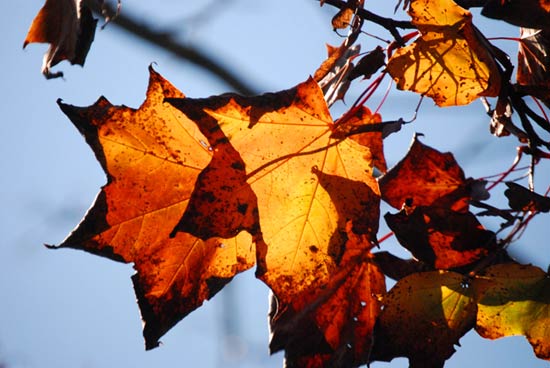Why Autumn Colors Are So Late

A gray, grim landscape used to greet residents of the Northeastern United States each November, but autumn's riot of red, orange and yellow came late this year. Delayed fall foliage also occurred in Chicago and parts of Europe.
Some say droughts and a warm summer played a role, while others wonder more broadly about global warming. In fact, it's rising levels of carbon dioxide, not the warmer temperatures fueled by the greenhouse gas, that have been delaying the transformation of green leaves, at least in Europe for a few decades, a new study suggests.
In the past 30 years, leaf color change across Europe has gradually occurred later and later, with a delay of about 1.3 to 1.8 days per decade. Like the early onset of spring blooms, this phenomenon has been explained as a result of Earth's rising temperatures.
But the correlation between rising temperatures and leaf color change, known as autumnal senescence, isn't as strong as it is for the spring bloom.
Researchers at the University of Southampton in England suspected that the rising carbon dioxide levels responsible for global warming might directly be influencing the timing of the autumnal color change.
They conducted two large forest experiments in which poplar trees were separated into two plots, with one plot exposed to ambient levels of carbon dioxide and the other exposed to elevated levels. (The elevated concentration was 550 parts per million—the predicted atmospheric level for 2050—while current ambient levels of carbon dioxide are 375 parts per million.)
The researchers found that trees exposed to elevated levels of carbon dioxide retained their leaves and stayed greener longer than those exposed to ambient levels. Their results are detailed in an online edition of the journal Global Change Biology.
Sign up for the Live Science daily newsletter now
Get the world’s most fascinating discoveries delivered straight to your inbox.
"The research data provide compelling evidence … that autumnal senescence in such forest ecosystems will be delayed as the atmospheric concentration of CO2 continues to rise, independent of increased temperatures," said study author Gail Taylor.
The elevated carbon dioxide levels keep photosynthesis going for longer and so maintain the greenness of the plant for more of the autumn "because a CO2 rich atmosphere allows the tree to generate carbon-rich compounds that are known to prolong the life of leaves," Taylor explained.
While the carbon dioxide keeps the leaves productive for longer, it also gives the tree less control over its period of dormancy, which it needs to prepare for the winter and spring. This could make the trees more susceptible to winter's chill, Taylor said.
- Video: Goldilocks and the Greenhouse
- Top 10 Surprising Results of Global Warming
- Fall Foliage: Why Leaves Change Color

Andrea Thompson is an associate editor at Scientific American, where she covers sustainability, energy and the environment. Prior to that, she was a senior writer covering climate science at Climate Central and a reporter and editor at Live Science, where she primarily covered Earth science and the environment. She holds a graduate degree in science health and environmental reporting from New York University, as well as a bachelor of science and and masters of science in atmospheric chemistry from the Georgia Institute of Technology.









